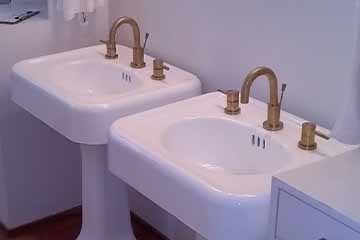
Low water pressure issues can be caused by your hot water heater, clogged aerator screens, pressure reducing valve problems, an issue with your water shutoff valve or even something as simple as a pipe leak somewhere in your plumbing system.
But what if you are having low water pressure problems when you are using more than one faucet? What could be causing that specific problem?
The answer is most likely an issue with a one or more ball valves. Of course it could be another cause or causes as well – a professional plumber would be able to identify the issue and fix it. But for this article, let’s assume it’s the most common cause – which is a problem with one or more ball valves.
What Does A Ball Valve Do?
A ball valve is a very common shut-off valve. They are used in both residential and commercial plumbing to turn the water on and off without affecting the water pressure.
The ball creates a powerful, watertight seal within the valve, preventing any fluid from escaping. Due to this tight seal, they’re also common in natural gas and chemical applications. Ball valves are also ideal for emergency applications where water needs to be cut off quickly and with ease. – freshwatersystems.com
So if the ball valve has broken or deteriorated in any way – you may end up having a problem with your water pressure when you turn on more than one fixture.
The solution here would be to replace the ball valve and if you have more than one – replace them one at a time and test your water pressure after each replacement.
What If the Low Water Pressure Problem Persists?
If replacing the ball valve didn’t do the trick, or you suspect that something else is causing the low water pressure problems then you can do the following.
Replace The Aerator Screens In Those Faucets
It seems unlikely but it’s certainly possible that the aerator screens on both faucets have become clogged. This would certainly be an easy fix so here are the steps how to clean out your aerator screens.
1. Use a pair of pliers to unscrew it. But cover the aerator with a washcloth first to avoid scratching it.
2. Disassemble it and clean it out.
3. Once you put it all back together screw it back onto the tip of the faucet.
4. Check the water pressure again to see if that did the trick.
5. If you find that the water pressure is still low – you can continue disassembling the faucet and cleaning out each area and then replacing it and of course testing it again.
Just a note of caution here – you may not be able to clean out your faucet – depending on how much sediment has been accumulated, the age of the faucet, etc. In this case – it may just be time to get a new faucet.
A Problem With Your Water Pressure Regulator
Water pressure regulators control the incoming pressure. Depending on design and condition of the inline filter, they can also greatly effect the pressure of water that is coming through your pipes.
Pressure regulators are mounted inline on the incoming water supply and can be exposed or buried. Like anything else, they can also wear out after some time so checking this and possibly replacing it may fix your low water pressure problems.
A Problem With The Main Water Meter
If there’s a problem with your water meter or for some reason it’s been turned off – then you will more than likely have problems with your water pressure.
So, check that your curb-side main water meter is completely turned on. If it’s locked (some cities won’t allow you to mess with the main water meter) contact your water department to send someone out to help you.
A Problem With Your Water Main Valve
Another possible source of your problems may be with your water main valve. This is the main valve in your home that turns off the water to every part of your home. Just like any other valve, it can become corroded or faulty after some time so you will also want to check your water main valve.
It may be that it’s not (for whatever reason) turned on all the way or some parts of the valve have decayed and need replacing.
A Problem With Your Hot Water Heater
Check the water pressure from every faucet in your home by turning on the cold water (then turn it off) and then turn on the hot water. If the problem with the pressure is only with the hot water – then the culprit is more than likely your hot water heater. If you determine that it may be the hot water heater then you will want to check it for problems with it leaking.
Pipes Are Leaking and/or Corroded
Normally, if you have a leak or corrosion in your plumbing system you would notice low water pressure throughout your home. But it may be that the problem pipes are closer to the faucets that are having the problem. A professional plumber would need to be called in to assess the issue and fix the problem.
If you have any questions about low water pressure or are having some problems with it, call Atlantis Plumbing today at 770-505-8570. We are available 24 hours a day, 7 days a week.